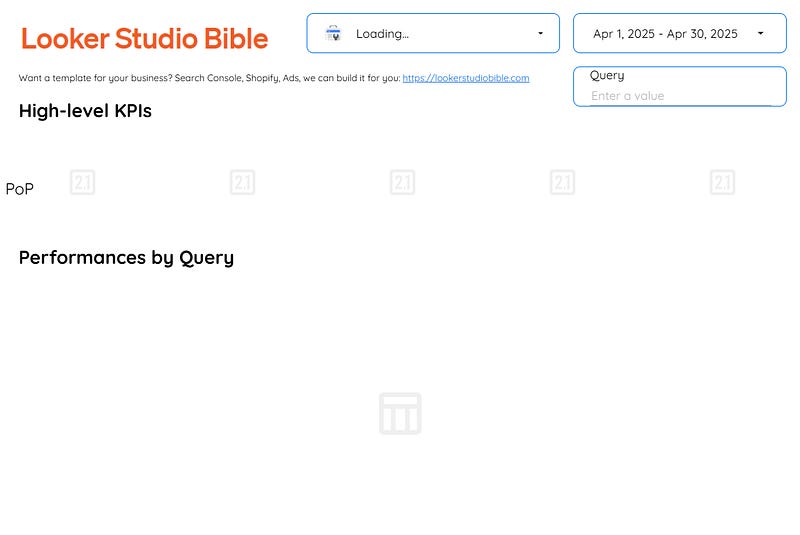How to make your slow reports faster in Looker Studio, our check list
Read carefully if you want to know the full list of solutions. But there is a silver bullet. Spoiler: use Extract Data. You’re welcome!
You’ve built your Looker Studio dashboard, you’re quite happy, but your users are struggling to use it? No worries, we’ve got you covered. In this article, we’ll share with you how to make your slow reports faster in Looker Studio, our check list.
First, bare in mind an important fact: although Looker Studio is an online tool, many processes depend on your internet connection and your own CPU. Meaning? It’s very possible that a report runs smoothly on your fast computer with great internet connection whilst not that smooth on your boss’s old computer with intermitent wi-fi. Never rule this out because sometimes, the issue does not lie on the report itself, hence you might have to find an out-of-the-box solution, report is not always to blame.
Please find below our check list, from main offenders to low impact best practices.
Looker Studio connectors we use on a daily basis and are happy with (w/ free trials): Supermetrics - Windsor - Catchr - PMA - Funnel (some affiliate links, still good tools!)
Not sure which one to pick? Reviews here and there. Still unsure?! Contact us with your tech stack and budget, and we’ll guide you in the right direction:
Main offenders, or how to improve performances by 60% easy peasy
These are the real deals:
Limit number of data sources and pre-blend: the more data sources, the more data calls Looker Studio will have to make, as obvious as it sounds. So instead of having numerous data sources, try to pre-blend (through Google Sheet, Big Query / your database, a third-party connector, …) all into a single data source, and see your performances sky-rocket
Prefer static data over dynamic data: If you’re getting data from a database for instance, try to point to a table and not use a query (and make sure your table gets updated as well), it will reduce processing time and make your report WAY faster. For Google Sheet, point to a static sheet, that could be a copy/paste value of a sheet with formulas. Objective here is to reduce processing time anywhere you can
Make sure third-party connectors host your data and don’t run calls all the time: When you change a filter, some third-party connectors just access their cache data, good. But others re-run API calls to Google, Meta, Shopify, … For a single account, it’s fine, when you’ve got 10… So make sure to know if your connector has or not cache data
-> Use Extract Data <-: Last but not least, if you’re unsure about the above, use Extract Data to use cache data within Looker Studio in your report. By far, the best solution to most of your problems
Prefer pre-calculated data over raw data: If you won’t use individual information, why sending your full data and count it in Looker Studio rather than just sending the counted number in the first place?!
These have an impact, but lower than the list above
Next category items will have an impact, but not as big. Good for tweaking till the end:
Only retrieve fields you’ll use: Humans have the tendency to go for the shortest path. Like, getting all the fields available in a data source. Well, no, if you won’t use them, just don’t retrieve them, it can help
Remove useless dataviz: It’s not because you can report on everything that you should. It might not be useful from a business perspective whilst also worsen performances, lose-lose situation
Don’t grant Editor role to everyone: Editors have the mighty power to refresh data on the go, Viewers can’t. If your team members don’t need to Edit the report, keep them to Viewers, ensuring data calls are reduced
Set default filters to reduce data displayed: First loading time is key, so use default filters to only display a limited period of time + only a few categories, speeds up loading and reduce frustation by a lot
Limit usage of blended data: Where possible, pre-blend in the data sources rather than blending data sources, these are heavy on processes and make everything slower. Also, if you have to, only use dimensions/metrics you need and set filters to reduce calculations
Limit usage of pivot tables: sometimes you need them but they are heavy on ressources, so use with scarcity
Best pratices, unsure about the real impact here
People make their bed every morning although they will re-join it this very day. Same here, not mandatory, limited impact, but at least it makes you happy to see things uncluttered:
Reduce datafreshness frequency: Can help if you tend to work long hours on a report, impact unclear
Limit usage of calculated fields: Again, try to make calculation before connecting the data sources, it’s not the most heavy on machines, but can help a bit
Keep your room tidy: delete unused filters, parameters, variables, blends, calculated fields, data sources, … Not a game changer, things you do because you do
If after these, your reports are still struggling, we only see a couple of solutions:
Split pages into different reports
Consider that you’ve got way too much data, and that Looker Studio is not the right tool for your use case (as sad as it might seem!)
PROBLEM SOLVED
The infamous affiliate links section. Still, these are tools we do use and do like a lot. To be said, we use other tools we’d rather not publicize given the headache they cause!
Todoist: for tasks management
Clickup: for projects management, when tasks fall short
Monday: for CRM & automation
Tropical Server: our friends in charge of the hosting of this very website!
Tools we use through clients’ accounts (and we’d use internally if we had the budget…):

